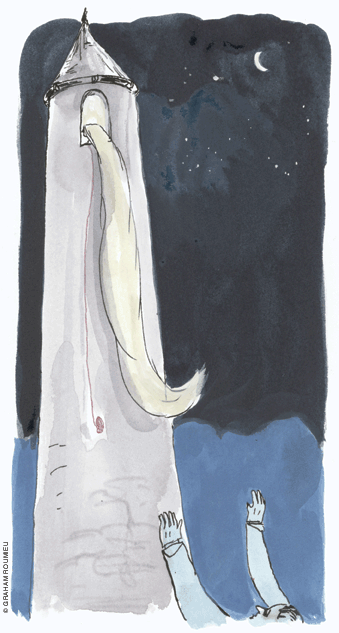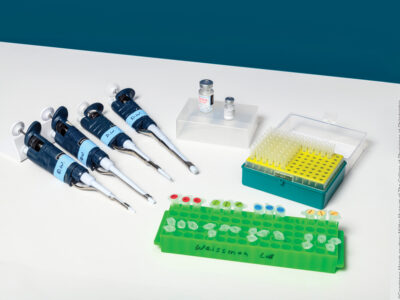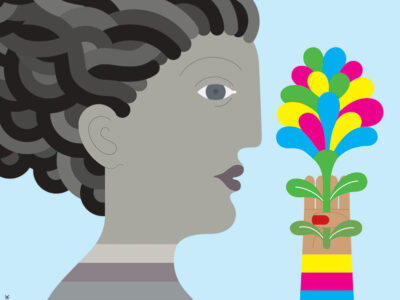
Class of ’70 | If the Philadelphia Phillies hadn’t won the pennant in 1993, Joan Saltzman G’70 might not have a husband today. But she’d probably still have both of her kidneys.
When Saltzman’s hometown underdogs made it past the Atlanta Braves to face Toronto in the World Series that year, the never-married 45-year-old lawyer suddenly had an excuse to pursue an unlikely crush. Two months had passed since she’d met “Mr. Seemingly Right,” York University (Toronto) film professor John Katz, at the Montreal World Film Festival. Katz was almost 10 years older, had been married twice and already had a girlfriend, but Saltzman had a feeling about him.
Seizing on the upcoming baseball showdown between their respective cities, she playfully sent him a Phillies cap to get his attention. Occasional phone calls during the run-up to the Series soon turned into chats that lasted whole games. And before she knew what had hit her, Saltzman had won a date in New York with her future husband. What she didn’t know yet was that Katz was nearing end-stage kidney failure.
As Saltzman relates in her recent memoir, Mr. Right and My Left Kidney (Peripety Press, 2006), that revelation came in the wake of tousled hotel bedsheets and Katz’s confession that his most current relationship hadn’t come to an end. Unsurprisingly, the courtship they’d just embarked on would be anything but a storybook romance. A miserable trip to Arizona together led Saltzman to issue an ultimatum that put their relationship on ice for a year; Katz only managed to cut ties with his prior girlfriend when she fell for another woman.
Smaller obstacles continued to crop up between Saltzman and Katz as they maintained a long-distance relationship, but they drew closer once again, and in January 1996 found themselves on Philadelphia’s Jeweler’s Row ordering a $35 marcasite ring. As they walked away, Katz asked, “How about if that’s our engagement ring?” It wasn’t the kind of proposal Saltzman had dreamed about, but all things considered, it was coming from the right man.
By this time, Katz had begun grasping at straws to fend off the frightening prospect of dialysis. He put his hopes on a no-protein diet advocated by a Johns Hopkins researcher he began visiting every few months, but his health continued to decline. So did his morale, food lover that he was. In a rare stroke of good fortune, York University offered him an early retirement at about the same time a cinema-studies teaching position opened up at Penn.
The happy coincidence was auspicious for more than his impending marriage. Although he didn’t know it at the time, coming to the University brought him into the orbit of the Penn Transplant Center, which was on the cusp of adopting a new surgical technique that was transforming the dynamics of kidney donation.
A week after they married in March 1997, Saltzman and Katz visited Dr. Robert Grossman, a nephrologist and professor of medicine at Penn who raised the possibility of a spousal kidney transplant. It was not an idea Saltzman, a medical malpractice litigator, wanted to entertain.
“I’ve always been sort of altruistic,” she says, “but there’s a point where altruism ends. And for me, I was wondering whether that point was kidney donation.”
Elective surgery scared her. After all, her own surgical history featured a tonsillectomy at age six that had necessitated a second trip to the hospital when she awoke bleeding from her throat.
Yet Katz’s condition was only getting worse. By the end of 1998, the teacher known for pacing about during his lectures had been forced to conduct his classes sitting down.
“I was in a really bad state,” he recalls. “I was very close to being catatonic. I had absolutely no energy—I came home from teaching and just fell asleep.”
When he was put on the kidney waiting list, Saltzman agreed to a blood test that would determine whether she could donate one of her own.
“I figured that I would just let myself be carried along in the process hoping that somewhere along the line I would be ruled out,” she confesses in her memoir. Instead, she found out she was a match: “Part of me felt that I was hurtling inevitably toward an operation I didn’t want.”
The classic surgery performed on kidney donors involves removing the organ through a 10-inch incision. Although quite safe, patients are susceptible to side effects like hernia and chronic wound bulging, and recovery times are measured in months.
What eventually convinced Saltzman to give up her left kidney was that Penn surgeons had changed that status quo. In late 1997, a surgical team led by Dr. Kenneth Brayman, then an associate professor of surgery at Penn, successfully extracted a donor kidney laparoscopically—making several half-inch incisions and employing a tiny camera to sever the organ, catch it in something resembling a butterfly net, and take it out through a modest three-inch cut.
On December 14, 1999, Saltzman parted ways with her kidney in the Hospital of the University of Pennsylvania. Dr. Ali Naji, the J. William White Professor of Surgery who had been involved in that first laparoscopic transplant at Penn, inserted it into the body of her husband. In less than a month, Katz returned to the classroom at Penn, where he taught film studies until retiring in 2006.
Today he is enjoying the present, cooking, and trying to play catch-up in the gift-giving department. “I gave her an Elsa Peretti kidney-shaped necklace,” he says. “It’s from Tiffany’s, so it seems to me that that’s worth a kidney.”
Saltzman has now moved away from medical malpractice litigation to focus on teaching, and aspires to a second career as a writer.
“When I was thinking of giving John my kidney, there was nothing to read that would have helped me,” she says. “A book like mine might have helped me. I believe so strongly that this was the best thing I’ve ever done.”—T.P.




